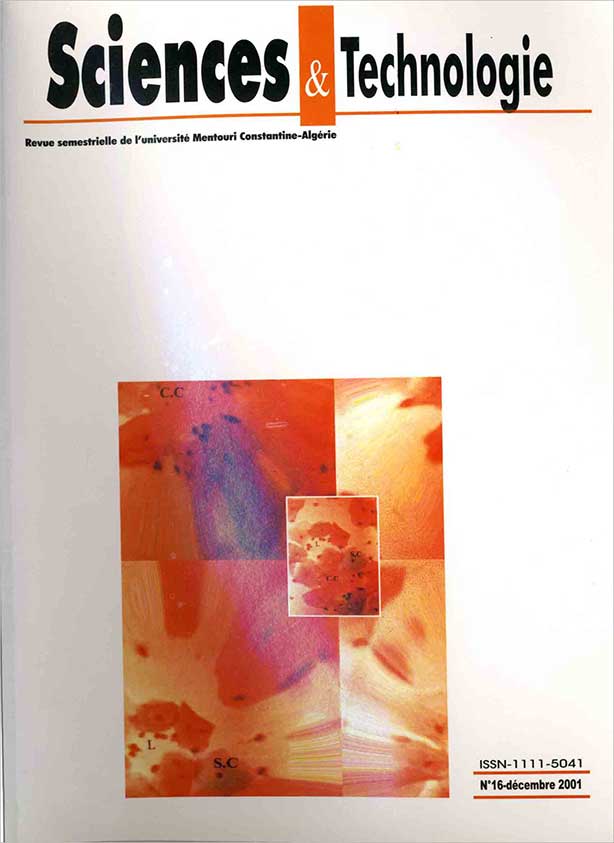EFFET DE L’ACIDE SALICYLIQUE SUR LA FRAGILITE OSMOTIQUE DES ERYTHROCYTES HUMAINS
Mots-clés :
Fragilité osmotique, TL50, acide salicylique, érythrocyte, hémoglobineRésumé
L’effet de l’acide salicylique (AS) sur la fragilité osmotique a été étudié chez les érythrocytes humains in vitro. De faibles concentrations de l'AS (0-0.50 mg/ml) ne montrent aucun effet hémolytique en cas d'incubation de ces érythrocytes dans du NaCl isotonique. Cependant, ces mêmes concentrations augmentent considérablement l'hémolyse hypotonique (C50).
On n'a enregistré aucune diminution dans l’amplitude des pics d’absorption de l'hémoglobine (Hb) en présence de l’AS entre les concentrations 0.05 et 0.20 mg/ml. Par contre, une première diminution de cette amplitude est enregistrée à 0.25 mg/ml et accentuée à 0.30 mg/ml. Cependant, le pic d’absorption à 0.35 mg/ml disparaît complètement.
Le temps de lyse de 50% (TL50) des érythrocytes incubés dans du NaCl hypotonique (C50) est comme suit: TL50(AS) < TL50(témoin).
Téléchargements
Références
- Fabre R. et Truihaut R., "Précis de toxicologie", Ed.: Société d’édition d’enseignement supérieur, Paris, (1965).
- Sachin N.B., Roger P.M. and Samar N.D., "Pharmacology in medicine: Principles and Practice", Ed.: Sp Press International Inc. U.S.A., (1986).
- Wajcman H., Lantz B. et Girot R., "Les maladies du globule rouge", Ed.: INSERM/Médecine-Science, Flammarion, Paris, (1992).
- Antunes-Madeira M.C., Carvalho A.P. and Madeira V.M.C., "Interactions of insecticides with erythrocyte membranes", 15, (1981), pp.79-89.
- Godal H.C., Elde A. T., Nyborg N. and Brosstad F., "The normal range of osmotic fragility of red blood cells. Scand", J. Haematol., 25, (1980), pp.107-112.
- Parpart A.K., Lorenz P.B., Parpart E.R., Gregg J.R. and Chanse A.M., "The osmotic resistance (fragility) of human red cells", J. Clin. Invest., 26, (1947), pp.630-640.
- O’Brien R.D. and Hilton B.D., "The effect of DDT and its analogs on the fragility of human erythrocytes", Pest. Biochem. Physiol., 9, (1978), pp.231-236.
- Houcher B., "L’hémolyse osmotique des érythrocytes humains, bovins et ovins. Effets du lindane, du taux de gonflement et de la température", Thèse de Magistère, Institut de Biologie, Université de Sétif, (1995).
- Sanford D.M. and Knodel L.C., "Induction of hemolytic anemia by nonsteroidal antiinflammatory drugs", Drug. Intell. Clio. Pharm., 20, (1986), pp.925-934.
- Minami T. et Cutler D.J., "A kinetic study of the role of band 3 anion transport protein in the transport of salicylic study and other hydroxybenzoic acids across the human erythrocyte membrane", J. Pharm. Sci., 81. (1992), pp. 424-427.
- Ohsako M., Matsumoto Y. and Goto S., "Transport of aspirin and its metabolites through erythrocyte membrane", Biol. Pharm. Bull., 16, (1993), pp. 154-157.
- Chan T.K., Todd D. and Tso S.C., "Drug induced hemolysis in G-6-PD-deficiency", Br. Med. J., 2, (1976), pp.1227-1229.
- Li A., Seipelt H., Muller C., Shi Y. et Artmann M., "Effect of salicylic acid derivatives on red cell membranes",
Pharmacol. Toxicol., 85, (1999), pp. 206-211.
- Mayer K. and Ley A.B., "Hemolysis of red cells due to sulfone", Ann. Intern. Med., 72, (1970), p. 711.
- Beutler E., "Red cell metabolism and hemolysis", Acta Haematol. Jpn. 50, (1987), p.1453
- Chmid F.R. and Culic D.D., "Antiinflammatory drugs and gastro intestinal bleeding: Comparison of aspirin and ibuprofen", J. Clin. Pharmacol., 16, (1976), pp.418-425.
- Fernandes M.A., Geraldes C.F., Oliveira C.R. and Alpoim M.C., " Chromate-induced human erythrocyte haemoglobin oxidation and peroxidation: influence of vitamin E, vitamin C, salicylate, deferoxamine and N-ethylmaleimide", Toxicol. Lett., 114, (2000), pp. 237-243.
- Bernard J., Plevy J., Varet B., Clavel J., Rain J. et Sultan Y., "Abrégé d’hématologie", Ed. Masson, Paris, (1985).
- Christopher J., Morris J., Earl R., Charles W., Trenam D. and Blake R., "Reactive oxygen species and iron a dangerous partner ship in inflammation", Int. J. Biochem. Cell. Biol., 27, (1995), pp.109-122.
- Rosen G.M., Barber M.J. and Rauckman E.J., "Disruption of erythrocyte membrane organisation by superoxide", J. Biol. Chem., 258, (1982), p.2225.
- Watala C. and Gwozdinski, "Effect of aspirin on conformation and dynamics of membrane proteins in platelets and erythrocytes, Biochem. Pharmacol., 45, (1993), pp. 1343-1349.
- Okahata, S., "Mechanism of methyl viologen induced hemolysis", Hiroshima Journal of Medical Sciences, 29, 2, (1980), pp. 49-54.







